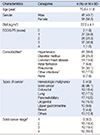Abstract
Purpose
This study aimed to investigate clinical characteristics of venous thromboembolism (VTE) in cancer patients.
Methods
We retrospectively analyzed clinical characteristics in patients with VTE confirmed with cancer. Multivariable logistic regression was used to identify differences associated with the development, between the pulmonary embolism (PE) and deep vein thrombosis (DVT) groups.
Results
From January 2009 to December 2014, a total of 103 patients with VTE were included in the final analysis: mean age, 70.6±11.8 years; female, 56.3%. Most of the patients had a solid cancer (95.1%), and half of all patients had distant metastasis (50.5%). Proportion of patients with VTE who received chemotherapy within a year was 64.1%. Central venous catheters were applied to 59 patients within 6 weeks before the diagnosis of VTE. The proportion of patients with DVT only among VTE patients was 21.4%. In logistic regression analysis, central venous catheter insertion (OR=2.66, 95% CI=1.09, 6.49; p=.032), as well as lung metastasis (OR=2.94; 95% CI=1.06, 8.18; p=.039) were significant predictors for PE rather than DVT only.
Figures and Tables
Table 1
General Characteristics of Participants (N=103)

Table 2
Clinical Characteristics of VTE (N=103)

Table 3
Treatment Modalities Characteristics of VTE (N=103)

Table 4
Baseline Characteristics between Patients with PE and Those with DVT Only (N=103)

References
1. Khorana A, Francis C, Culakova E, Kuderer N, Lyman G. Thromboembolism is a leading cause of death in cancer patients receiving outpatient chemotherapy. J Thromb Haemost. 2007; 5(3):632–634.

2. Goldhaber SZ, Tapson VF, Committee DFS. A prospective registry of 5,451 patients with ultrasound-confirmed deep vein thrombosis. Am J Cardiol. 2004; 93(2):259–262.

3. Bang SM. Diagnosis and treatment of venous thromboembolism in cancer patients. Korean J Med. 2013; 85(5):481–484.

4. Park YS, Lim SJ, Lee T. Prevention of venous thromboembolism in hip surgery patients. Hip Pelvis. 2014; 26(1):1–6.

5. Bhagya RB, Kalayarasan R, Kate V, Ananthakrishnan N. Venous thromboembolism in cancer patients undergoing major abdominal surgery: prevention and management. ISRN Vasc Med. 2012; 2012:1–22. http://www.hindawi.com/journals/isrn/2012/783214.

6. Heit JA, Silverstein MD, Mohr DN, Petterson TM, O'Fallon WM, Melton LJ. Risk factors for deep vein thrombosis and pulmonary embolism: a population-based case-control study. Arch Intern Med. 2000; 160(6):809–815.

7. Song KY. Prevention and treatment of venous thromboembolism in cancer patients. Korean J Clin Oncol. 2009; 5(2):32–40.

8. Chew HK, Wun T, Harvey D, Zhou H, White RH. Incidence of venous thromboembolism and its effect on survival among patients with common cancers. Arch Intern Med. 2006; 166(4):458–464.

9. Choi S, Lee KW, Bang SM, Kim S, Lee JO, Kim YJ, et al. Different characteristics and prognostic impact of deep-vein thrombosis/pulmonary embolism and intraabdominal venous thrombosis in colorectal cancer patients. Thromb Haemost. 2011; 106(6):1084–1094.
10. Jang M, Bang SM, Oh D. Incidence of venous thromboembolism in Korea: from the Health Insurance Review and Assessment Service database. J Thromb Haemost. 2011; 9(1):85–91.

11. Morrison R. Venous thromboembolism: scope of the problem and the nurse's role in risk assessment and prevention. J Vasc Nurs. 2006; 24(3):82–90.

12. Heit JA, Silverstein MD, Mohr DN, Petterson TM, O'Fallon WM, Melton LJ. Predictors of survival after deep vein thrombosis and pulmonary embolism: a population-based, cohort study. Arch Intern Med. 1999; 159(5):445–453.

13. Lee JE, Kim HR, Lee SM, Yim JJ, Yoo CG, Kim YW, et al. Clinical characteristics of pulmonary embolism with underlying malignancy. Korean J Intern Med. 2010; 25(1):66–70.

14. Sørensen J, Klee M, Palshof T, Hansen H. Performance status assessment in cancer patients. An inter-observer variability study. Br J Cancer. 1993; 67(4):773–775.

15. Otten MM, Mathijssen J, ten Cate H, Soesan M, Inghels M, Richel DJ, et al. Symptomatic venous thromboembolism in cancer patients treated with chemotherapy: an underestimated phenomenon. Arch Intern Med. 2004; 164(2):190–194.

16. Mousa SA, Petersen LJ. Anti-cancer properties of low-molecular-weight heparin: preclinical evidence. Thromb Haemost. 2009; 102(2):258–267.

17. Levine MN, Gent M, Hirsh J, Arnold A, Goodyear MD, Hryniuk W, et al. The thrombogenic effect of anticancer drug therapy in women with stage II breast cancer. N Engl J Med. 1988; 318(7):404–407.

18. Blom JW, Doggen CJ, Osanto S, Rosendaal FR. Malignancies, prothrombotic mutations, and the risk of venous thrombosis. JAMA. 2005; 293(6):715–722.

19. Anthony M. Nursing assessment of deep vein thrombosis. Medsurg Nurs. 2013; 22(2):95–98.
20. Kim JS, Kim HJ, Woo YH, Lym JY, Lee CH. Effects on changes in femoral vein blood flow velocity with the use of lower extremity compression for critical patients with brain injury. J Korean Acad Nurs. 2009; 39(2):288–289.

21. Broviac J, Cole J, Scribner B. A silicone rubber atrial catheter for prolonged parenteral alimentation. Surg Gynecol Obstet. 1973; 136(4):602–606.
22. Verso M, Agnelli G. Venous thromboembolism associated with long-term use of central venous catheters in cancer patients. J Clin Oncol. 2003; 21(19):3665–3675.

23. Lee AY, Levine MN, Butler G, Webb C, Costantini L, Gu C, et al. Incidence, risk factors, and outcomes of catheter related thrombosis in adlut patients with cancer. J Clin Oncol. 2006; 24(9):1404–1408.

24. De Cicco M, Matovic M, Balestreri L, Panarello G, Fantin D, Morassut S, et al. Central venous thrombosis: an early and frequent complication in cancer patients bearing long-term silastic catheter. A prospective study. Thromb Res. 1997; 86(2):101–113.

25. Luciani A, Clement O, Halimi P, Goudot D, Portier F, Bassot V, et al. Catheter-related upper extremity deep venous thrombosis in cancer patients: a prospective study based on Doppler US 1. Radiology. 2001; 220(3):655–660.

26. Hutten BA, Prins MH, Gent M, Ginsberg J, Tijssen JG, Büller HR. Incidence of recurrent thromboembolic and bleeding complications among patients with venous thromboembolism irelation to both malignancy and achieved international normalized ratio: a retrospective analysis. J Clin Oncol. 2000; 18(17):3078–3083.





 PDF
PDF ePub
ePub Citation
Citation Print
Print



 XML Download
XML Download